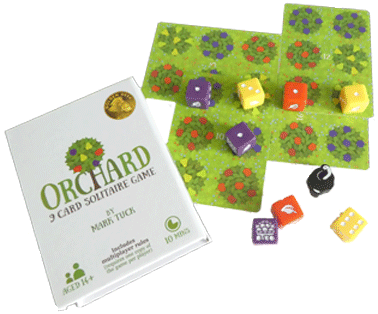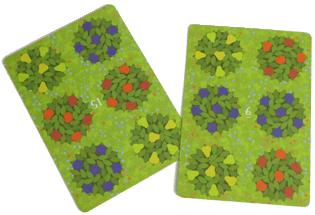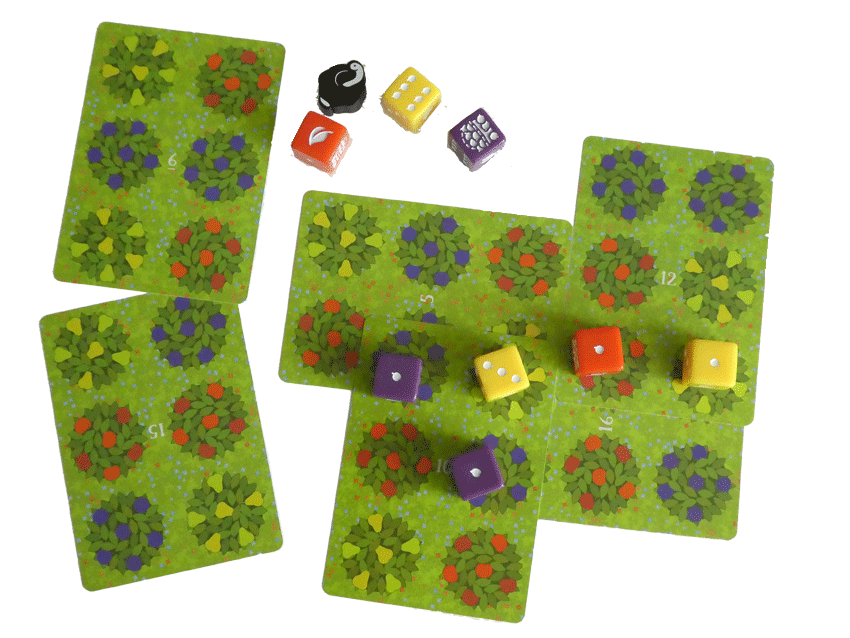
Being at the Orchard can be a relaxing experience – or a mildly frustrating one (yes, just mildly …. it’s a gentle game).

An aspect of this three-fruits Orchard that’s much appreciated is the game’s small size and great portability.
After all, it’s just a few cards, a few dice, and a pair of pieces of rotten fruit, complete with maggots.
But it packs a fruity punch despite its size.
Orchard (devised by Mark Tuck) won the Golden Geek award for print-and-play games in 2018. From its earliest days, it has been much liked within the solo-gaming community, to the extent that there are monthly “was it fruitful for you” competitions, available at BoardGameGeek (see bottom of page ).
The orchard’s made up of eighteen fruit-tree cards, fifteen fruity dice, two rotten fruit tokens, and a tiny rulebook. It’s totally contained within a little box that couldn’t be easier to carry around.
So, in your pocket you could have a burgeoning Orchard to harvest 😃
In Orchard, each card displays six trees, with a mix-up of red apples, yellow pears, and purple plums. The fifteen fruit dice also are coloured – five dice for each of the three fruits.
Orchard can be set-up in a few seconds, since the only effort that’s needed is to shuffle the deck of eighteen cards, deal nine face-down to yourself, and put the others aside for another game in a few minutes time.
Turn over the top card and put it down – it shows the first six trees in your orchard. The dice and the rotten fruit can sit nearby. Take the top two cards as your starting hand, and you’re ready to get growing.
On each turn, do just three simple things
First – Add one of the two cards in your hand
to the orchard.

It must overlap at least one of the cards already there – further down the line, new cards almost certainly can be placed to overlap more than one other of the same type – generating more fruit..
(Later, of course, you will have to temporarilly move dice aside to do this.)

At least one tree on the card you are playing must overlap a tree that’s already in the orchard.
That is, the fruit of the overlapping tree must match the fruit on the tree beneath it.
You cannot mix your fruits up though – a plum tree cannot sit atop an apple, for example
unless their fruit’s rotten – more later.
Second – the dice come into play. Each tree on the newly played card that overlaps a tree in the orchard calls for a die to come into action. If the overlapping tree did not have a die on it already, place one of the same colour as the tree onto the top card : showing value 1.
If a die was already sitting there before you covered the tree with the new card, put it back in place on the top tree, and raise its value (1►3►6►10), like the yellow pear tree above. The ’10’ has a basket of 10 fruits on display.
Already, you can see the size of your harvest increasing, and that’s the aim – to gather most fruit! 👍
Third – if there are cards still available, add one from the draw pile to your hand, and move on to the next turn.
Oh! Let’s not forget the rotten fruit!
You can use those two rotten fruit tokens – after all, no orchard’s ever perfect. Within each game you are allowed place these cards such that a tree on the top card does not match the one beneath it.
Place a rotten-fruit token to show that this tree is spoiled (you can place both tokens on the same card if you wish).
So spoiled is the tree that once the rotten fruit is hanging there, no other cards may be placed to cover it, and it can never be moved.
What a spoiler!
When can we start to gather the goodies?
The game ends at any time when you cannot place a card, or once you have placed the final card and dice.
Scoring is a matter of totalling up all the pips on the uppermost face of each die, and subtracting three from your score for each of the rotten fruits you’ve left dangling.
Scores are amusingly graded in the back of Mark Tuck’s rulebook ~ a particularly low score’s “pal-tree” 😁
The mechanics of Orchard are clean and simple, and you can probably finish it in ten minutes or less. Plenty of time for another … and another … and (think about it – how long do people play ordinary 52-card patience for?)
Every game is certain to be different, so you’re confronted with different options and decisions every time, and you’ll probably never become so expert that you’re bound to score high every time. You may, of course, become a better decision maker in some way or other.
Actually, the cards all are numbered, so the same game can be played several times. It’s simply a case of sorting nine cards into the correct order, and going again. Here’s a bit about how to do it.
What grows during the short space of every game is the difficult decision of how best to place each new card to maximise the harvest. Each turn there are but two cards available, and deciding which to use and how to best use it presents a perpetual puzzle.
The cards are all numbered, and that feature’s used for a competitive multiplayer game. For that to happen at home, each player needs to have a copy of the game, or you’ll need to take turns in playing when using just one copy.
Monthly good fun challenges – fun for casual players too. Anybody can join in with – and they’re well within reach of casual players.
Mark Tuck’s BGG challenges page
In a nutshell …
- takes mere seconds to set up each time
- the guide makes all very clear
- luck is involved, but decisions matter mightily
- replayable
- quiet and calm under the trees
- WOW! click here to play the same game as others and compare your scores

